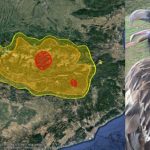← Back
Satellite Tracking Mexico’s Endangered Thick-Billed Parrot

The thick-billed parrot, a bright green bird once found in parts of the southwestern United States, now survives only in the high mountain forests of Mexico. These parrots are in trouble, fewer than 2,000 are left, and their survival depends on protecting the forests they call home. But until recently, we didn’t know exactly where these birds go throughout the year.
That changed thanks to an innovative study using Argos Services.

A First for Thick-Billet Parot: Satellite Tracking in the Wild
This was the first-ever satellite tracking study of wild thick-billed parrots. Scientists from the San Diego Zoo Wildlife Alliance and Mexican conservation group OVIS teamed up to tag 34 parrots with lightweight, solar-powered transmitters connected to the Argos system.
These tags sent real-time location data to satellites, giving researchers a bird’s-eye view of the parrots’ movements, without disturbing them in their natural habitat.
What the Thick-Billed Parrot Satellite Tracking Revealed
The Argos data uncovered some incredible facts about these parrots:
- Seasonal Migration: All tracked parrots migrated seasonally, leaving their breeding sites in October and returning around April.
- Long Journeys: Their migrations ranged from 173 to 765 km, sometimes taking as little as 3 days or as long as 181 days.
- Traveling in Groups: Parrots migrated in tight social groups, often leaving together within a few days of each other.
- Important Stopovers: Over half of the migration routes included stopover sites, places where the birds rested and refueled. The team discovered five previously unknown stopovers in remote mountain forests.
- New Nest Found: The tracking also led to the discovery of a new nesting site near Madera, Chihuahua which was confirmed with a ground visit.

SSM-filtered thick-billed parrot tracks from a representative individual parrot (id = TBP23) telemetered at the Tutuaca nesting site in Oct-21 and tracked across a 500 km migration completed in 24 days from the northern nesting sites to the southern overwintering habitats. Location data were resampled at 12-hour intervals and colored according to the associated move persistence (γt), continuous-valued between 0 (low move persistence) and 1 (high move persistence). Extent of primary growth high-elevation pine and pine-oak forest (green polygons) displayed for reference. (Center) Range shift plots circles are (dark to light) the 50% and 95% areas of use and indicate range shift plots with three ranges (two shifts) plotted on UTM easting (X axis) and northing (Y axis) coordinates in meters. (Right) Time series on the time series plot x-axis are in days from initial capture beginning 06-Oct with blue lines reflecting confidence intervals around the estimated means (also plotted against X-Y UTM coordinates). A range shift was confirmed by the model (d.f. = 4, l.r.t = 315, p < 0.005, RSI = 4.0 (95% CI 3.8–4.3)), as was the stopover indicated by the central range circles and spatial shift in the middle of the time series (d.f. = 4, l.r.t = 113, p < 0.005).
Why Habitat Matters
By combining the movement data with maps of forest conditions, scientists learned that these parrots prefer:
- High elevations
- Tall trees with wide trunks
- Old-growth pine and mixed pine-oak forests
These findings confirm that thick-billed parrots depend heavily on old, mature forests, the very habitats most at risk from logging, wildfires, and climate change.
Unfortunately, less than 20% of their habitat is formally protected, and many crucial areas like stopovers and overwintering grounds have no conservation status at all.

What This Means for Conservation
The Argos tracking helped scientists pinpoint exactly where and when conservation efforts are most needed. Thanks to this study, we now know:
- Where parrots breed, rest, and overwinter
- Which forest areas are most important for their survival
- That larger protected zones are needed, especially outside the breeding season
The data can now be used to guide forest protection, restoration, and land-use planning in Mexico. It may even help support future reintroduction efforts in the U.S.
Left: Mean AKDE home ranges with CIs for thick-billed parrot locations recorded at the northern breeding sites and southern overwintering sites. Center: Mean migratory route area defined via 95% Kriged occurrence distribution estimate (blue polygon) with five stopover sites defined by the 25% occurrence contour (purple polygons). Orange polygons indicate seasonal home range areas. Right: Conditional distribution of encounters for parrots at the breeding and overwintering sites indicating a higher likelihood of encounters concentrated around the nesting locations.
A Model for Future Wildlife Protection
This project shows how technology like Argos can play a vital role in protecting endangered species. With more studies like this, conservationists can move from guessing to knowing, and make smarter, faster decisions to safeguard wildlife.
This work was made possible by support from organizations like CONANP, the San Diego Zoo Wildlife Alliance, the World Parrot Trust, and many local communities in northern Mexico.
Read the full scientific article here Spatial behaviors and seasonal habitat use of the increasingly endangered thick-billed parrot (Rhynchopsitta pachyrhyncha) – ScienceDirect




